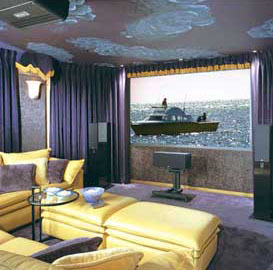 |
CRT Primer
|
Updated: April 2006 |
Screen Sizes
There is no one perfect screen size for any projector. The die-hards say that
one should never exceed a 7’ wide screen to get the perfect picture out of even
a 9” projector, but I used to use entry level 7” video projectors at high school
dances onto a 12’wide screen back in the mid 80’s with good results. Not a
perfect picture, but completely watchable.
In general, I recommend between an 8’ and 10’ diagonal 4:3 screen for most
home theatres and bars.
There is of course a catch with a video screen. Most DVD and HDTV material is
in 16:9 widescreen mode, while most regular TV broadcasts and VHS tape are still
in the standard TV 4:3 format. If you use a 16:9 screen, 4:3 images will be off
the top and bottom of the screen, while a 16:9 image watched on a 4:3 screen
will have blank space top and bottom of the screen. For those that have the room
and budget, I recommend a fixed 16:9 screen permanently attached to the wall,
while a second 4:3 screen may be lowered in front of the 16:9 for regular TV
viewing.
CRT projectors do not have the capability to convert 16:9 into 4:3 images and
vice versa. What you feed into a projector is what it will produce on the
screen. Many line doublers or scalers have the ability to convert a 4:3 image to
project within a 16:9 screen, so that the height of the image remains constant,
but the 4:3 image will then be smaller than the wide 16:9 format screen. Note
that a 16:9 screen will use less phosphor area of a CRT tube than a 4:3 screen.
If you set up a 4:3 image within a 16:9 screen, even less phosphor area is used,
so it will depend on how many hours a year you watch either format and if you
plan on changing tubes down the road on your projector as to how you set up your
projection screen. Generally speaking, you will most likely see some 4:3 wear
within a 16:9 screen after about 4000-5000 hours of use. Conversely, I would
estimate that you would see some 16:9 wear within a 4:3 screen after 5000-6000
hours of use.
|
|


